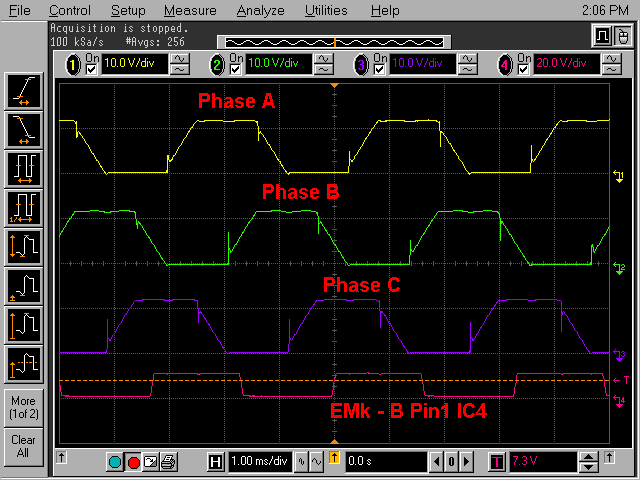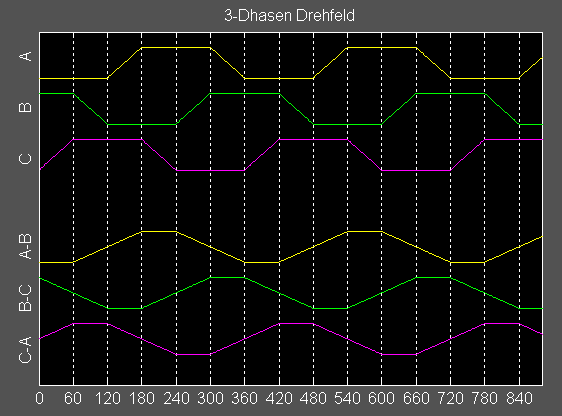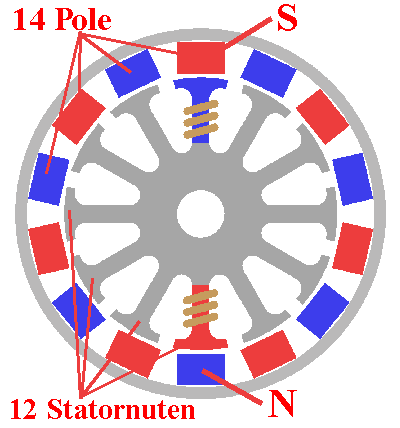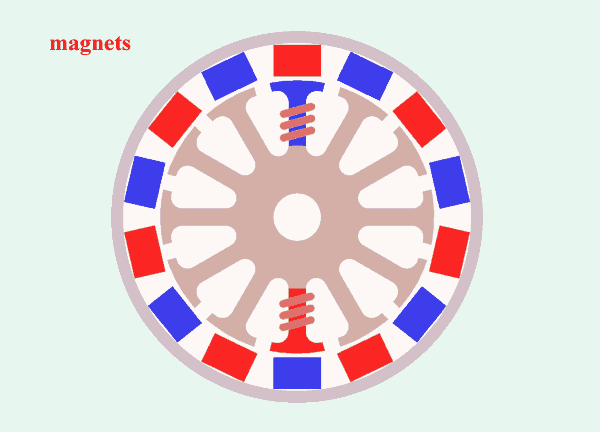Why
does the Torquemax rotate so slowly and so forcefully
by Peter Rother
This question was amazing me months ago. Therefore I've started
to seek answer. After reading the first
article by Ludwig Retzbach in German Electro-Modell I was
not sure, how the rotating magnetic field really works. Why was
the opposite winding
180 degree out of phase? After the second article I was little bit clever. But
first building the LRK350-20-15
engine and watching it running gave me the whole knowledge. Specially
after been exposed to its very strong propeller thrust, I said
I had to know why !!!
Classic
3-phase drive
At first we should grab out some
knowledge, that many of us have had at school. How does the 3-phase
motor work? Let's take a short view on voltages supplied to such
3-phase motor. Each output of such 3-phase driver switch on the
negative battery voltage for the whole 120 degrees (see yellow
upper trace, marked Phase A) . Than switches off for 60 degrees
(line ramps up slowly) and switches on, this time positive battery
voltage for 120 degrees. On the end switches off again for 60
degrees. All three controller outputs are shifted by 120 degrees
giving totally 6 different drive phases over the whole 360 degrees
period (every 60 degrees something happens).
Following diagram has been made
during real measurements on brush less controller. Modern digital
scopes allow to capture pictures and send them to the PC for
further work. The lowest trace (magenta) shows the position signal
generated by special circuitry observing voltages on the motor.
This signal, one of three, is essential for the microprocessor
to determine where the rotator actually resides.
Please click on the diagram to
zoom in.

Next picture can not be easy
generated on the scope. This picture has been made in MATLAB
as subtraction of all Phases, A, B, C. This picture shows currents
in our triangle-connected windings. Phase-A to Phase-B is A-B,
B to C is B-C and C to A is C-A. We see that currents are very
similar to periodic sinus signal, which would be the optimum.
These lower-half traces can represent currents, but also magnetic
forces in each of 120-degrees-spaced directions. Adding all these
vectorial forces give us well known 3-phase rotating field. The
magnets, outside or inside, will follow this rotation. This is
the principle of every motor.

Torque
at 3-phase 2-pole inner runner
The principle showed above will
be used in any 2-pole inner runner. Inner runner means: coils
are sitting outside in the stator (that stays in place, as the
name says) and one magnet with, of course, two poles rotates
inside. All modern well known brush less engines follow this
principle: AVEOX, Hacker, LMT etc. Diameter of the magnet is
small, 10 to 20 mm (1/2 to 1 inch).
While the radius is small, the
circumference 2*PI*r is small. Therefore cylinder area is small
also. While the Neodym magnets have limited field density, all
magnetic forces are small.
Short calculation for 200 watt
inner runner:
Magnetic induction in in the magnetic gap between air winded
coils and magnets is smaller then 1 Tesla, about 0.8 T. Therefore
force per cm^2
F = A x 4
B ^ 2 = A * 2,56 N
Only 65% of the circumference
will be loaded with magnets, therefore force per area is:
0,65 x 2,56
N/cm2 = 1,66 N/cm2
In the inner runner with 18 mm
magnet diameter and 20 mm magnet length the area is:
A = PI*D*h
= 11,3 cm2
Force in the air gap:
F x A = 18,8
N
Torque of magnet with 9 mm
radius:
M = F x r
= 18,8 N x 0,009 m = 0,17 Nm
Power at 50,000 rpm:
P = 2 * PI
* M * rpm /60 = 886 W
Assumed a prop 14x8 with n100w=4240 should be driven by this motor. Such
prop rotates with 8773 rpm at 886 W. We have to reduce
revolution from 50,000 to 8,773 by gear box of 5.7:1. Torque increases with this ratio to
5.7*0.17=0.97
Nm
Torque
at 14-pole outside runner, LRK350-20
Force between stator and magnet
cylinder is:
F = A x 4
B ^ 2
For the Neodym magnet with B
= 1 T the force per area is 4 N/cm2.
Only 65% of circumference will be loaded with magnets. Therefore:
0,65 x 4 N/cm2
= 2,6
N/cm2
At outside runner with 35 mm
diameter and 20 mm magnet length the bell area is:
A = PI*D*h
= 22 cm2
The force in air gap is:
F x A = 57
N
The torque of this motor is:
M = F x D/2
= 57 N x 0,035 m /2 = 1 Nm
This torque is 6 times higher, than for the presented inner runner.
At this moment we see that
|
LRK350-20
doesn't need any gear box and can drive big props directly. |
Number
of revolution at Torquemax

Time point Phase A
In this picture current flows
through upper coil (Phase A in 3-phase system) and the S-pole
magnet will be pulled. This is a stable position. No magnet will
pulled to the left or right.
Phase A/B - 60° to the
right.
In this 12-slot stator only every
second tooth will winded. Now, 60 degrees to the right, current
flows through the coil on the 3rd tooth (not show on the picture).
The magnetic field has rotated also 60 degrees to the right.
There are 14 magnets in the bell, 7 pole pairs over 360 degrees
distributed. Look at the picture. When 3rd tooth is energized,
the next S-pole (red one in the picture) is in the position of
360/7=51.42°. This pole will pulled to the right by
the angle of
Delta
phi = 360/6 - 360/7 = 360/42 = 8.57°
|
This is the point!
The field has rotated by 360/6=60° and the magnets bell only
by 360/42=8.57°, 7
times slower.
When the field rotates
360° during the whole one 3-phase cycle, the magnets bell
rotates only by 360/7=51,43°. |
Now
little bit mathematics:
The LRK motor is a special motor
(only second tooth winded). The number of magnetic pole pairs
must be greater or smaller by one then number of stator winded
teeth. In our case 6 winded teeth and 7 magnet pairs.
Equations:
k=1,2,3,4,...
at LRK k=1
winded teeth/slots
= 6 * k = 6
Stator-slots
= 12 * k = 12
Magnets-pole-pairs
= 6 * k +/- 1 = 7
Magnets count
= 2 * 7 = 14
revolution
reduction = 1 / pole pairs = 1 / 7
Animation
of the rotating 14-pole outside runner.
I have made this animation to
show how it works. Look at one red magnet for few seconds and
then at rotating coil, that represents rotating magnetic field.
The magnetic bell is rotating 7 times slower.

Praxis:
The 3-phase field is rotating
at 42,000 rpm, the magnets bell and he propeller at 42,000/7=6,000rpm.
Many
measuremnst are done here
Summary:
1. The torque
for outside runner is much higher then for inner runner, practically
4 to 8 times higher.
2. Because
of the ratio 7 to 6, the propeller is rotating 7 times slower,
then magnetic field.
hc |



